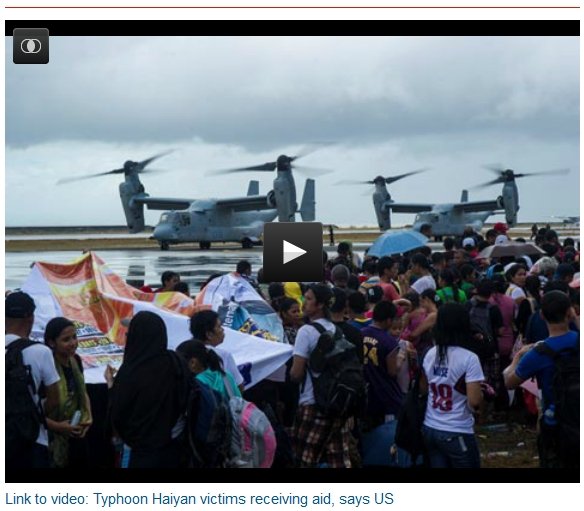Officials post death toll of 4,000 in Tacloban city alone, with UN confirming some of worst-hit areas have received no aid
Friday 15 November 2013: The painfully slow pace of relief efforts after the typhoon in the Philippines has let people down, the United Nations aid chief has said, admitting that teams have yet to reach areas with people in desperate need.
Valerie Amos's assessment from the devastated city of Tacloban came as the aid effort rapidly gathered pace, with the US aircraft carrier George Washington and its escort of two cruisers arriving in the disaster zone amid fresh promises of help from other nations. David Cameron said the UK would send its own carrier, HMS Illustrious.
The official death toll from typhoon Haiyan, known in the Philippines as Yolanda, stood at 2,357 on Thursday night. But in Tacloban city hall a notice was posted saying 4,000 people had been killed in that city alone, double the previous day's estimate of 2,000, the Reuters news agency reported, while the UN was putting the overall body count for the disaster at 4,460.
On Friday morning the BBC quoted the Philippines interior secretary, Mar Roxas, as saying the official government death toll was 3,422. News emerged that a regional police chief had been removed for giving an initial figure of 10,000 in the typhoon's immediate aftermath – infuriating President Benigno Aquino III, who has played down casualty figures and the desperate, chaotic state of affected communities.
Aid workers estimate the final total will be considerably higher, citing the lack of information from remote areas.
Amos said conditions for survivors were dismal. Many had gone days without food and some were drinking from polluted wells or standing water because they were left with no alternative.
"I do feel that we have let people down because we have not been able to get in more quickly," Amos told reporters.
Of the newly increased flow of aid she said: "It would have been better if it had happened three days ago. We are getting there but it's far too slow." While the delivery of supplies from Cebu and Manila to the disaster zone has improved, many of the goods still appear to be stuck at the three major relief bases in Tacloban, Ormoc and Guiuan.
By late afternoon on Thursday the Philippines navy and air force had transported relief goods across the Visayas island group, which includes the areas of Leyte, Samar and Cebu, officials said.
 |
But further rain has hampered distribution and the refusal of petrol station owners to reopen facilities has led to transport problems and a stark dilemma, according to the mayor of Tacloban, Alfred Romualdez. "The choice is to use the same truck either to distribute food or collect bodies," Romualdez said.
The city's administrator, Tecson Lim, estimated that only a fifth of residents were receiving aid.
Security concerns also prompted some aid organisations to evacuate teams.
Plan International has withdrawn all 15 of its employees – normally permanently based in Tacloban – until security is restored, said a spokesman. A memo was circulating among relief workers advising them not to move around in the city as some UN staff had already been pulled out for security reasons.
On Wednesday stories of heightened violence and tension circulated as eight were killed after stampeding a rice warehouse looking for food.
A Philippine Red Cross convoy was allegedly hijacked by armed men who were reportedly later shot dead by police, and a 13-year-old boy was reportedly knifed in the neck and stomach by unknown men.
Amid unconfirmed stories ranging from the seizure of aid to traffickers targeting women and children by posing as relief workers, officials urged people to stay calm and not believe everything they heard.
"There have been so many reports of looting and rape which have turned out not to be correct," Ricky Caradang, a spokesman for President Aquino, told the local ABS-CBN TV channel.
Father Anton Pascual, who is leading a team for the catholic charity Caritas, said that its religious status had helped it deliver aid to families in remote villages: "We wear our priest collars and we are able to go through," he said.
Officials have pointed to an increased presence of police and military, and the influx of supplies, as a turning point for Tacloban. Roads are gradually being cleared of fallen trees and debris.
Some residents have blamed sheer inefficiency for the relief delays, arguing that a country that suffers an average of 20 typhoons a year should have proper contingency plans.
"I don't think we could have prepared for this," budget secretary Florencio Abad told Reuters, adding that the authorities' response this time was faster than previous disasters.
Even in Tacloban city, supplies had yet to reach the Astrodome, where thousands are sheltering in squalid conditions.
"I wonder when they will bring food here," said Erlinda Rosales, 72. Her family received rations for the first time on Thursday – 3kg of rice and three cans of sardines – but only because her granddaughter had walked to their village council every day.
Some residents have complained of favouritism, suggesting that those with connections to authorities were getting better treatment.
At Tacloban's airport, where thousands waited in their desperation to flee the city, there was also suspicion being voiced by many at the official explanations that airlifts for children, the sick and elderly people came first.
"If you have a friend or relative in the military, you get priority," complained Violeta Duzar, 57. She and eight relatives, including children, had been waiting there since Sunday.
Around 6,000 people have been evacuated by the Philippines armed forces, a spokesman said, with 4,000 leaving by air and the rest by sea.


